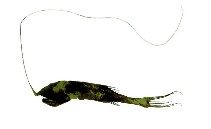| Family: |
Gigantactinidae (Whipnose anglers) |
| Max. size: |
11.65 cm SL (male/unsexed); 35.4 cm SL (female) |
| Environment: |
bathypelagic; marine; depth range 650 - 2500 m |
| Distribution: |
Atlantic Ocean and Pacific Ocean. |
| Diagnosis: |
Dorsal spines (total): 0-0; Dorsal soft rays (total): 5-6; Anal spines: 0-0; Anal soft rays: 5-6. Metamorphosed females distinguished by the following characteristics: length of illicium 340-447% SL; escal bulb with lightly pigmented truncated distal prolongation; 6-20 long distal filaments; escal papillae absent; proximal escal papillae absent; short dentary teeth (longest 1.3-3.4% SL, average 2.3% SL), arranged posteriorly in two longitudinal series; length of caudal fin rays less than 45% SL; weakly developed skin coverage of proximal part of caudal fin; caudal fin rays free nearly to base (Ref. 86949). |
| Biology: |
Appear to be active predators which feed on midwater fishes, including Cyclothone acclinidens, Triphoturus mexicanus and Bathylagus stilbius; cephalopods like Vampyroteuthis; and various invertebrates like amphipods, natant decapod crustaceans and coelenterates (Ref. 4525). Maximum length for female from Ref. 41361. |
| IUCN Red List Status: |
Least Concern (LC); Date assessed: 11 October 2018 Ref. (130435)
|
| Threat to humans: |
harmless |
Source and more info: www.fishbase.org. For personal, classroom, and other internal use only. Not for publication.
